Equality and Diversity Exam - Analysis of Scenarios and UK Law
VerifiedAdded on 2021/02/19
|6
|1463
|282
Homework Assignment
AI Summary
This assignment examines various scenarios related to equality and diversity, focusing on the application of the Equality Act 2010 in the United Kingdom. The first scenario addresses disability discrimination, specifically the lack of accessibility for wheelchair users, and discusses reasonable adjustments required by law. The second scenario defines diversity and equality in the workplace, emphasizing the employer's duty to treat employees equally and identifying the nine protected characteristics under the Equality Act. The third scenario tackles issues of gender reassignment, discussing the appropriate treatment and care for individuals undergoing gender transition. The assignment provides legal context, definitions, and practical recommendations for ensuring inclusive practices and avoiding discrimination in different settings, including healthcare. The assignment includes references to relevant literature and legal frameworks.
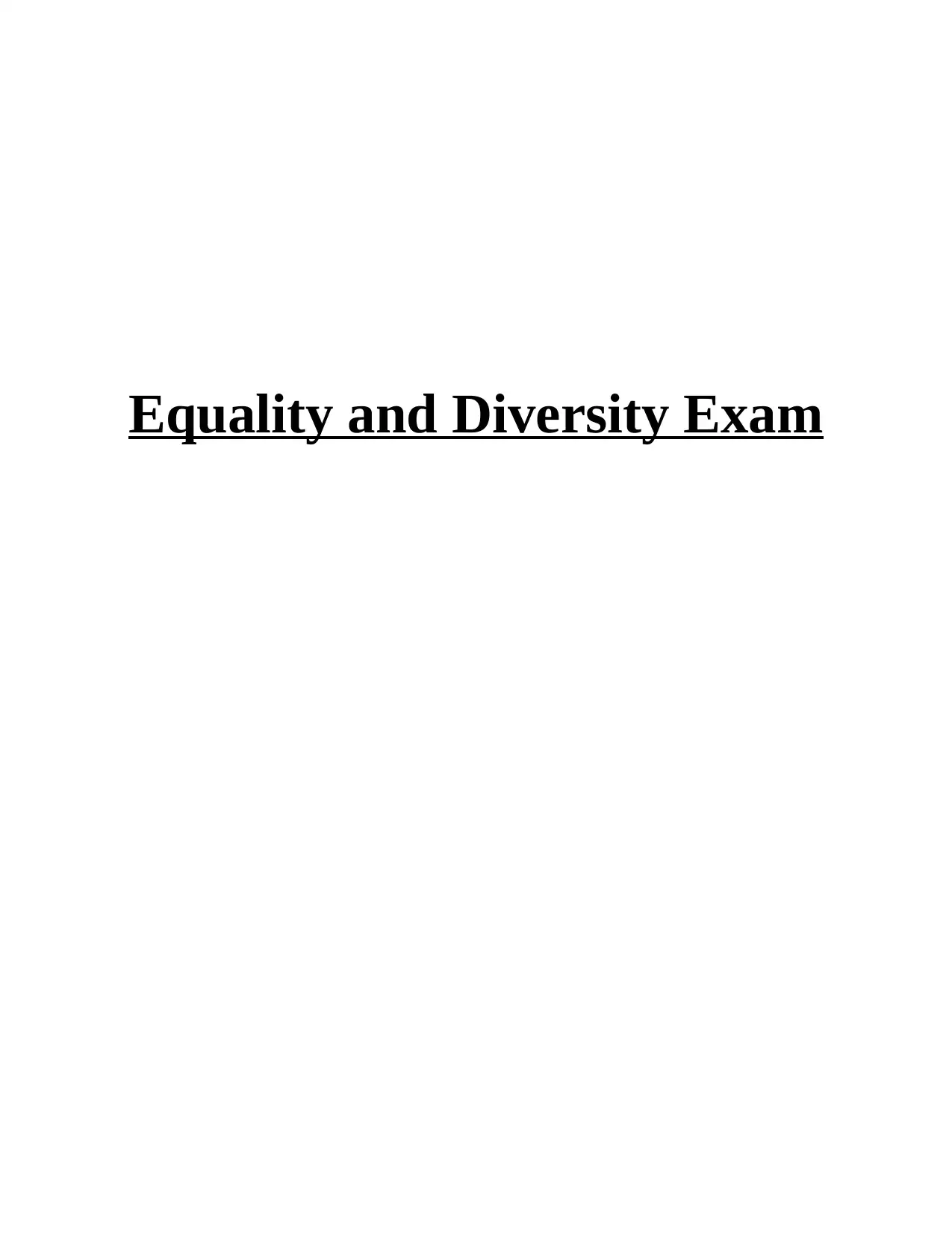
Equality and Diversity Exam
Paraphrase This Document
Need a fresh take? Get an instant paraphrase of this document with our AI Paraphraser
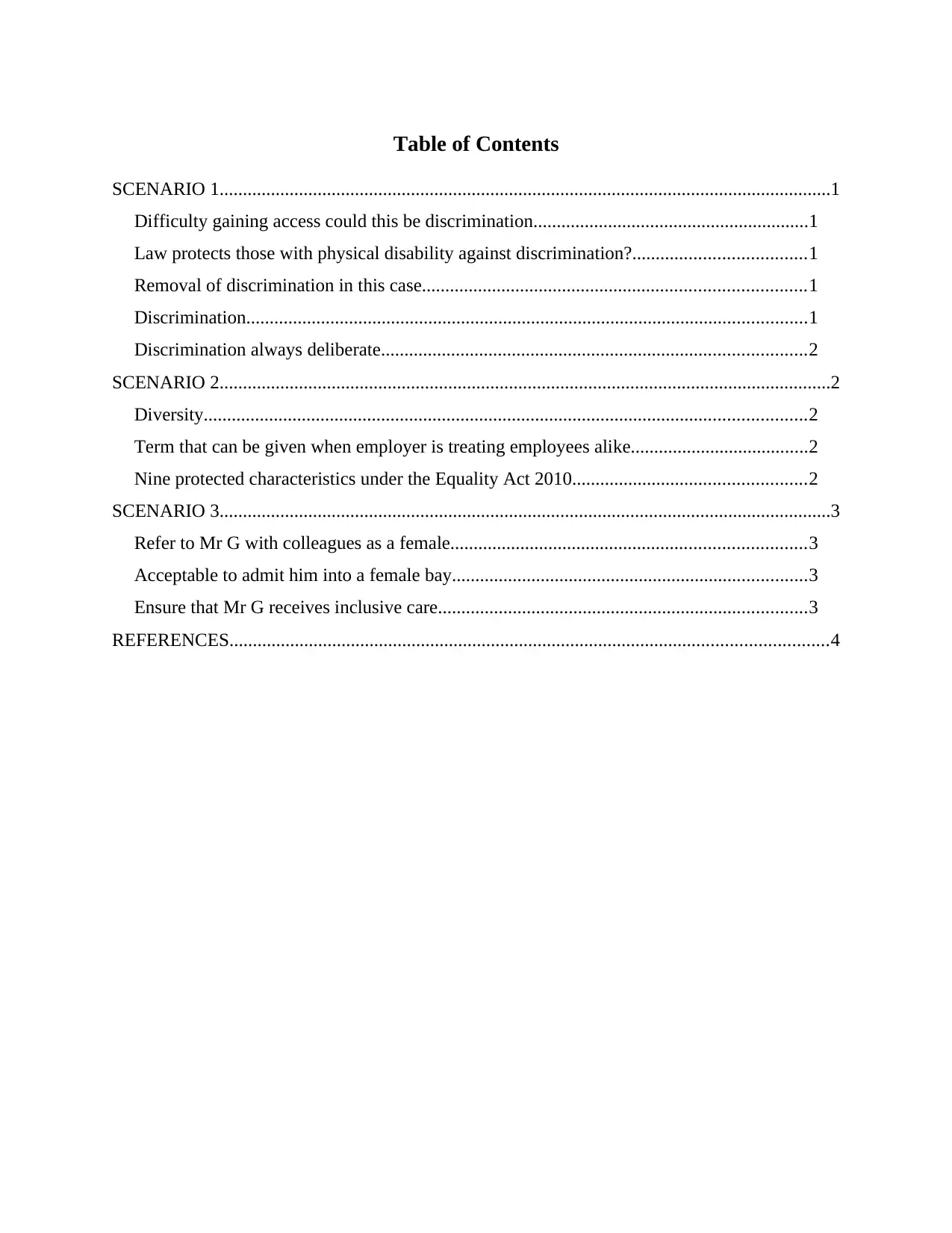
Table of Contents
SCENARIO 1...................................................................................................................................1
Difficulty gaining access could this be discrimination...........................................................1
Law protects those with physical disability against discrimination?.....................................1
Removal of discrimination in this case..................................................................................1
Discrimination........................................................................................................................1
Discrimination always deliberate...........................................................................................2
SCENARIO 2...................................................................................................................................2
Diversity.................................................................................................................................2
Term that can be given when employer is treating employees alike......................................2
Nine protected characteristics under the Equality Act 2010..................................................2
SCENARIO 3...................................................................................................................................3
Refer to Mr G with colleagues as a female............................................................................3
Acceptable to admit him into a female bay............................................................................3
Ensure that Mr G receives inclusive care...............................................................................3
REFERENCES................................................................................................................................4
SCENARIO 1...................................................................................................................................1
Difficulty gaining access could this be discrimination...........................................................1
Law protects those with physical disability against discrimination?.....................................1
Removal of discrimination in this case..................................................................................1
Discrimination........................................................................................................................1
Discrimination always deliberate...........................................................................................2
SCENARIO 2...................................................................................................................................2
Diversity.................................................................................................................................2
Term that can be given when employer is treating employees alike......................................2
Nine protected characteristics under the Equality Act 2010..................................................2
SCENARIO 3...................................................................................................................................3
Refer to Mr G with colleagues as a female............................................................................3
Acceptable to admit him into a female bay............................................................................3
Ensure that Mr G receives inclusive care...............................................................................3
REFERENCES................................................................................................................................4
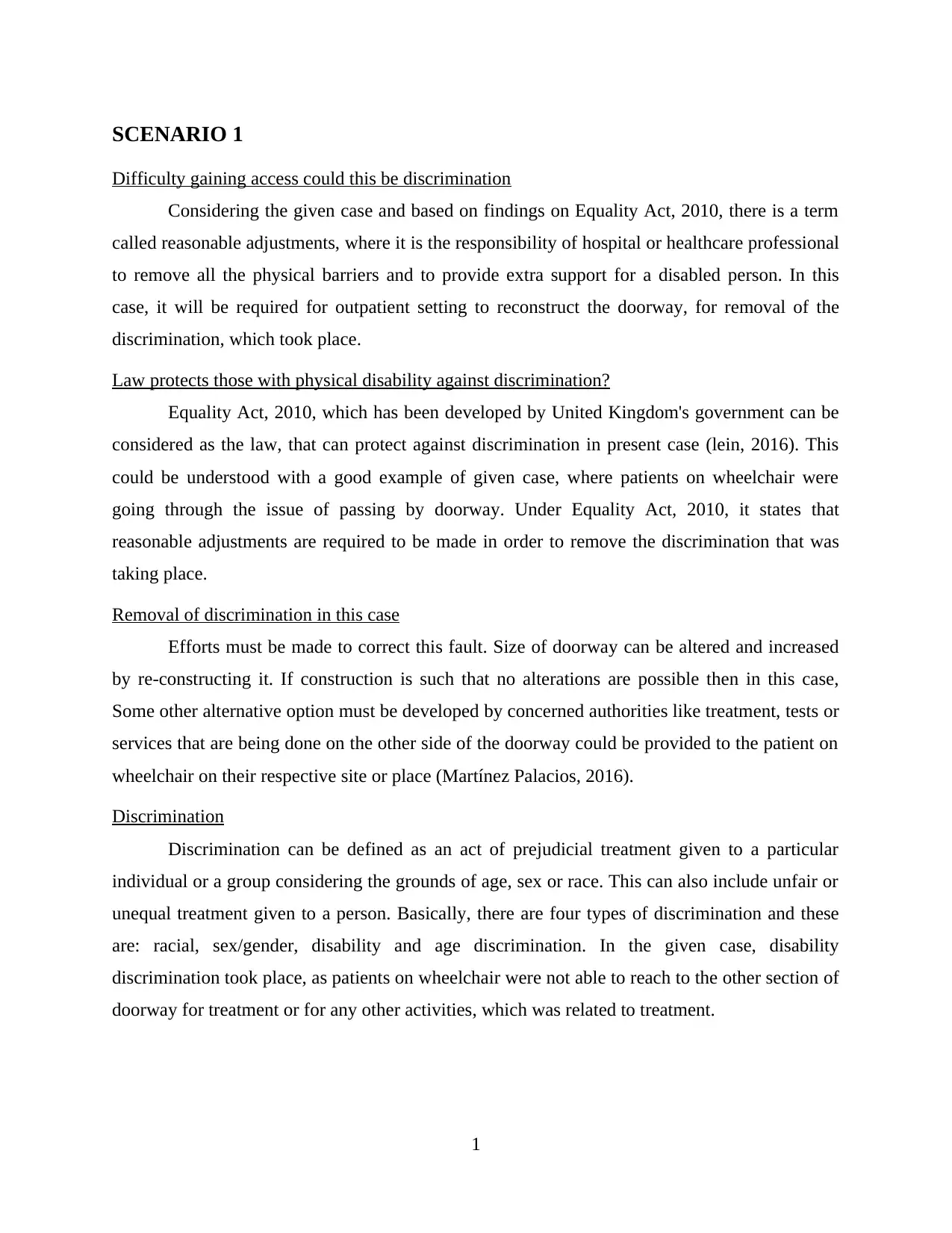
SCENARIO 1
Difficulty gaining access could this be discrimination
Considering the given case and based on findings on Equality Act, 2010, there is a term
called reasonable adjustments, where it is the responsibility of hospital or healthcare professional
to remove all the physical barriers and to provide extra support for a disabled person. In this
case, it will be required for outpatient setting to reconstruct the doorway, for removal of the
discrimination, which took place.
Law protects those with physical disability against discrimination?
Equality Act, 2010, which has been developed by United Kingdom's government can be
considered as the law, that can protect against discrimination in present case (lein, 2016). This
could be understood with a good example of given case, where patients on wheelchair were
going through the issue of passing by doorway. Under Equality Act, 2010, it states that
reasonable adjustments are required to be made in order to remove the discrimination that was
taking place.
Removal of discrimination in this case
Efforts must be made to correct this fault. Size of doorway can be altered and increased
by re-constructing it. If construction is such that no alterations are possible then in this case,
Some other alternative option must be developed by concerned authorities like treatment, tests or
services that are being done on the other side of the doorway could be provided to the patient on
wheelchair on their respective site or place (Martínez Palacios, 2016).
Discrimination
Discrimination can be defined as an act of prejudicial treatment given to a particular
individual or a group considering the grounds of age, sex or race. This can also include unfair or
unequal treatment given to a person. Basically, there are four types of discrimination and these
are: racial, sex/gender, disability and age discrimination. In the given case, disability
discrimination took place, as patients on wheelchair were not able to reach to the other section of
doorway for treatment or for any other activities, which was related to treatment.
1
Difficulty gaining access could this be discrimination
Considering the given case and based on findings on Equality Act, 2010, there is a term
called reasonable adjustments, where it is the responsibility of hospital or healthcare professional
to remove all the physical barriers and to provide extra support for a disabled person. In this
case, it will be required for outpatient setting to reconstruct the doorway, for removal of the
discrimination, which took place.
Law protects those with physical disability against discrimination?
Equality Act, 2010, which has been developed by United Kingdom's government can be
considered as the law, that can protect against discrimination in present case (lein, 2016). This
could be understood with a good example of given case, where patients on wheelchair were
going through the issue of passing by doorway. Under Equality Act, 2010, it states that
reasonable adjustments are required to be made in order to remove the discrimination that was
taking place.
Removal of discrimination in this case
Efforts must be made to correct this fault. Size of doorway can be altered and increased
by re-constructing it. If construction is such that no alterations are possible then in this case,
Some other alternative option must be developed by concerned authorities like treatment, tests or
services that are being done on the other side of the doorway could be provided to the patient on
wheelchair on their respective site or place (Martínez Palacios, 2016).
Discrimination
Discrimination can be defined as an act of prejudicial treatment given to a particular
individual or a group considering the grounds of age, sex or race. This can also include unfair or
unequal treatment given to a person. Basically, there are four types of discrimination and these
are: racial, sex/gender, disability and age discrimination. In the given case, disability
discrimination took place, as patients on wheelchair were not able to reach to the other section of
doorway for treatment or for any other activities, which was related to treatment.
1
⊘ This is a preview!⊘
Do you want full access?
Subscribe today to unlock all pages.

Trusted by 1+ million students worldwide
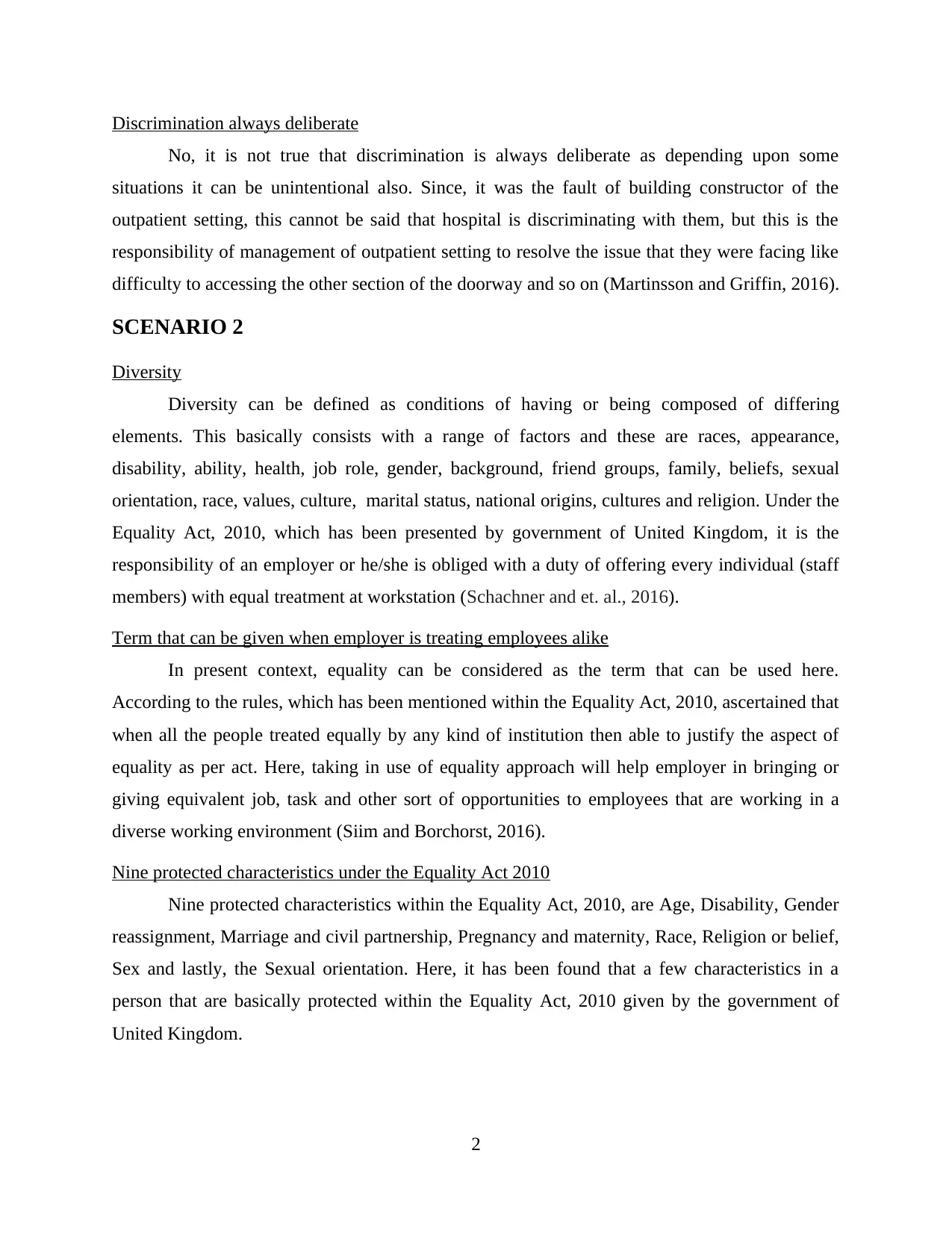
Discrimination always deliberate
No, it is not true that discrimination is always deliberate as depending upon some
situations it can be unintentional also. Since, it was the fault of building constructor of the
outpatient setting, this cannot be said that hospital is discriminating with them, but this is the
responsibility of management of outpatient setting to resolve the issue that they were facing like
difficulty to accessing the other section of the doorway and so on (Martinsson and Griffin, 2016).
SCENARIO 2
Diversity
Diversity can be defined as conditions of having or being composed of differing
elements. This basically consists with a range of factors and these are races, appearance,
disability, ability, health, job role, gender, background, friend groups, family, beliefs, sexual
orientation, race, values, culture, marital status, national origins, cultures and religion. Under the
Equality Act, 2010, which has been presented by government of United Kingdom, it is the
responsibility of an employer or he/she is obliged with a duty of offering every individual (staff
members) with equal treatment at workstation (Schachner and et. al., 2016).
Term that can be given when employer is treating employees alike
In present context, equality can be considered as the term that can be used here.
According to the rules, which has been mentioned within the Equality Act, 2010, ascertained that
when all the people treated equally by any kind of institution then able to justify the aspect of
equality as per act. Here, taking in use of equality approach will help employer in bringing or
giving equivalent job, task and other sort of opportunities to employees that are working in a
diverse working environment (Siim and Borchorst, 2016).
Nine protected characteristics under the Equality Act 2010
Nine protected characteristics within the Equality Act, 2010, are Age, Disability, Gender
reassignment, Marriage and civil partnership, Pregnancy and maternity, Race, Religion or belief,
Sex and lastly, the Sexual orientation. Here, it has been found that a few characteristics in a
person that are basically protected within the Equality Act, 2010 given by the government of
United Kingdom.
2
No, it is not true that discrimination is always deliberate as depending upon some
situations it can be unintentional also. Since, it was the fault of building constructor of the
outpatient setting, this cannot be said that hospital is discriminating with them, but this is the
responsibility of management of outpatient setting to resolve the issue that they were facing like
difficulty to accessing the other section of the doorway and so on (Martinsson and Griffin, 2016).
SCENARIO 2
Diversity
Diversity can be defined as conditions of having or being composed of differing
elements. This basically consists with a range of factors and these are races, appearance,
disability, ability, health, job role, gender, background, friend groups, family, beliefs, sexual
orientation, race, values, culture, marital status, national origins, cultures and religion. Under the
Equality Act, 2010, which has been presented by government of United Kingdom, it is the
responsibility of an employer or he/she is obliged with a duty of offering every individual (staff
members) with equal treatment at workstation (Schachner and et. al., 2016).
Term that can be given when employer is treating employees alike
In present context, equality can be considered as the term that can be used here.
According to the rules, which has been mentioned within the Equality Act, 2010, ascertained that
when all the people treated equally by any kind of institution then able to justify the aspect of
equality as per act. Here, taking in use of equality approach will help employer in bringing or
giving equivalent job, task and other sort of opportunities to employees that are working in a
diverse working environment (Siim and Borchorst, 2016).
Nine protected characteristics under the Equality Act 2010
Nine protected characteristics within the Equality Act, 2010, are Age, Disability, Gender
reassignment, Marriage and civil partnership, Pregnancy and maternity, Race, Religion or belief,
Sex and lastly, the Sexual orientation. Here, it has been found that a few characteristics in a
person that are basically protected within the Equality Act, 2010 given by the government of
United Kingdom.
2
Paraphrase This Document
Need a fresh take? Get an instant paraphrase of this document with our AI Paraphraser
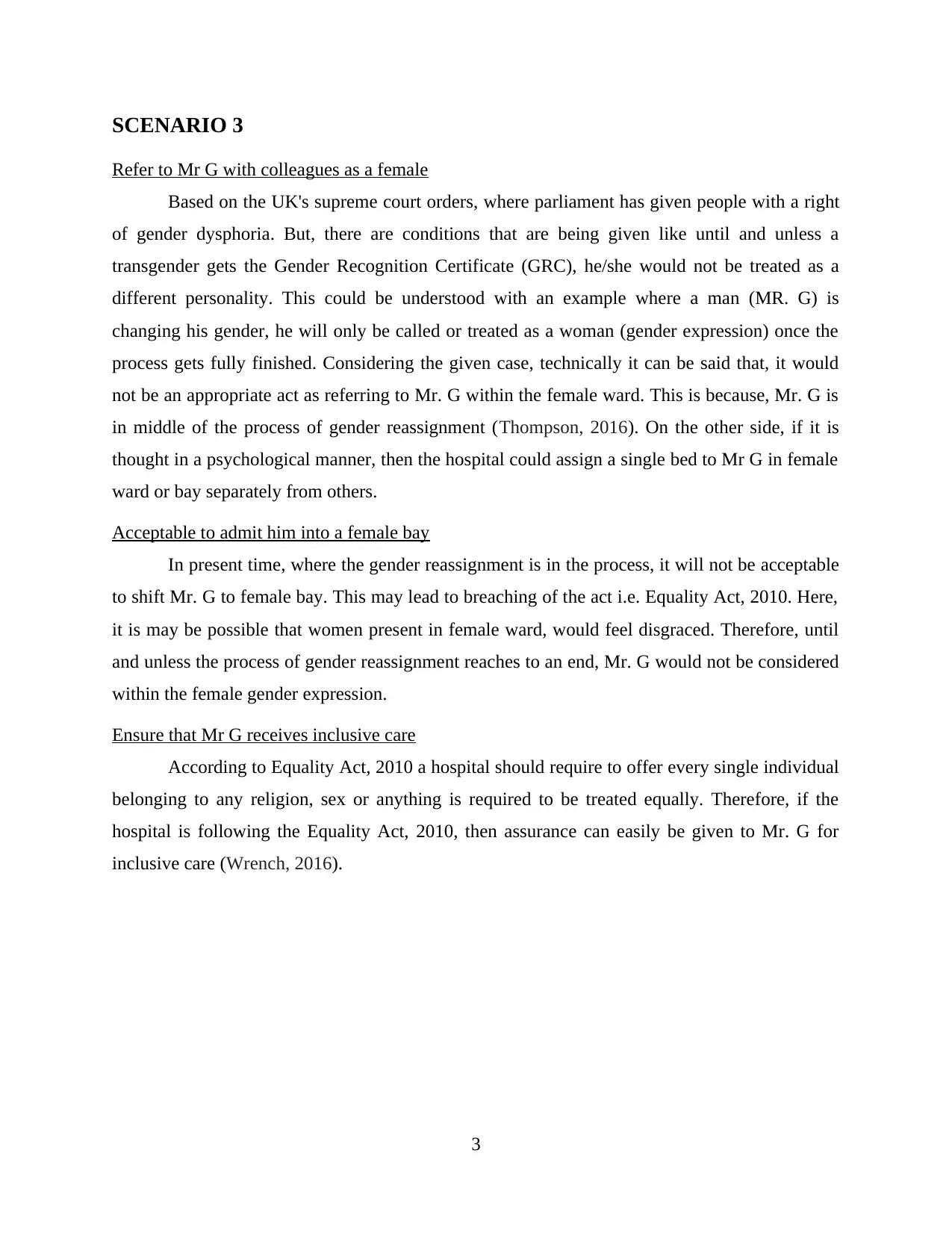
SCENARIO 3
Refer to Mr G with colleagues as a female
Based on the UK's supreme court orders, where parliament has given people with a right
of gender dysphoria. But, there are conditions that are being given like until and unless a
transgender gets the Gender Recognition Certificate (GRC), he/she would not be treated as a
different personality. This could be understood with an example where a man (MR. G) is
changing his gender, he will only be called or treated as a woman (gender expression) once the
process gets fully finished. Considering the given case, technically it can be said that, it would
not be an appropriate act as referring to Mr. G within the female ward. This is because, Mr. G is
in middle of the process of gender reassignment (Thompson, 2016). On the other side, if it is
thought in a psychological manner, then the hospital could assign a single bed to Mr G in female
ward or bay separately from others.
Acceptable to admit him into a female bay
In present time, where the gender reassignment is in the process, it will not be acceptable
to shift Mr. G to female bay. This may lead to breaching of the act i.e. Equality Act, 2010. Here,
it is may be possible that women present in female ward, would feel disgraced. Therefore, until
and unless the process of gender reassignment reaches to an end, Mr. G would not be considered
within the female gender expression.
Ensure that Mr G receives inclusive care
According to Equality Act, 2010 a hospital should require to offer every single individual
belonging to any religion, sex or anything is required to be treated equally. Therefore, if the
hospital is following the Equality Act, 2010, then assurance can easily be given to Mr. G for
inclusive care (Wrench, 2016).
3
Refer to Mr G with colleagues as a female
Based on the UK's supreme court orders, where parliament has given people with a right
of gender dysphoria. But, there are conditions that are being given like until and unless a
transgender gets the Gender Recognition Certificate (GRC), he/she would not be treated as a
different personality. This could be understood with an example where a man (MR. G) is
changing his gender, he will only be called or treated as a woman (gender expression) once the
process gets fully finished. Considering the given case, technically it can be said that, it would
not be an appropriate act as referring to Mr. G within the female ward. This is because, Mr. G is
in middle of the process of gender reassignment (Thompson, 2016). On the other side, if it is
thought in a psychological manner, then the hospital could assign a single bed to Mr G in female
ward or bay separately from others.
Acceptable to admit him into a female bay
In present time, where the gender reassignment is in the process, it will not be acceptable
to shift Mr. G to female bay. This may lead to breaching of the act i.e. Equality Act, 2010. Here,
it is may be possible that women present in female ward, would feel disgraced. Therefore, until
and unless the process of gender reassignment reaches to an end, Mr. G would not be considered
within the female gender expression.
Ensure that Mr G receives inclusive care
According to Equality Act, 2010 a hospital should require to offer every single individual
belonging to any religion, sex or anything is required to be treated equally. Therefore, if the
hospital is following the Equality Act, 2010, then assurance can easily be given to Mr. G for
inclusive care (Wrench, 2016).
3
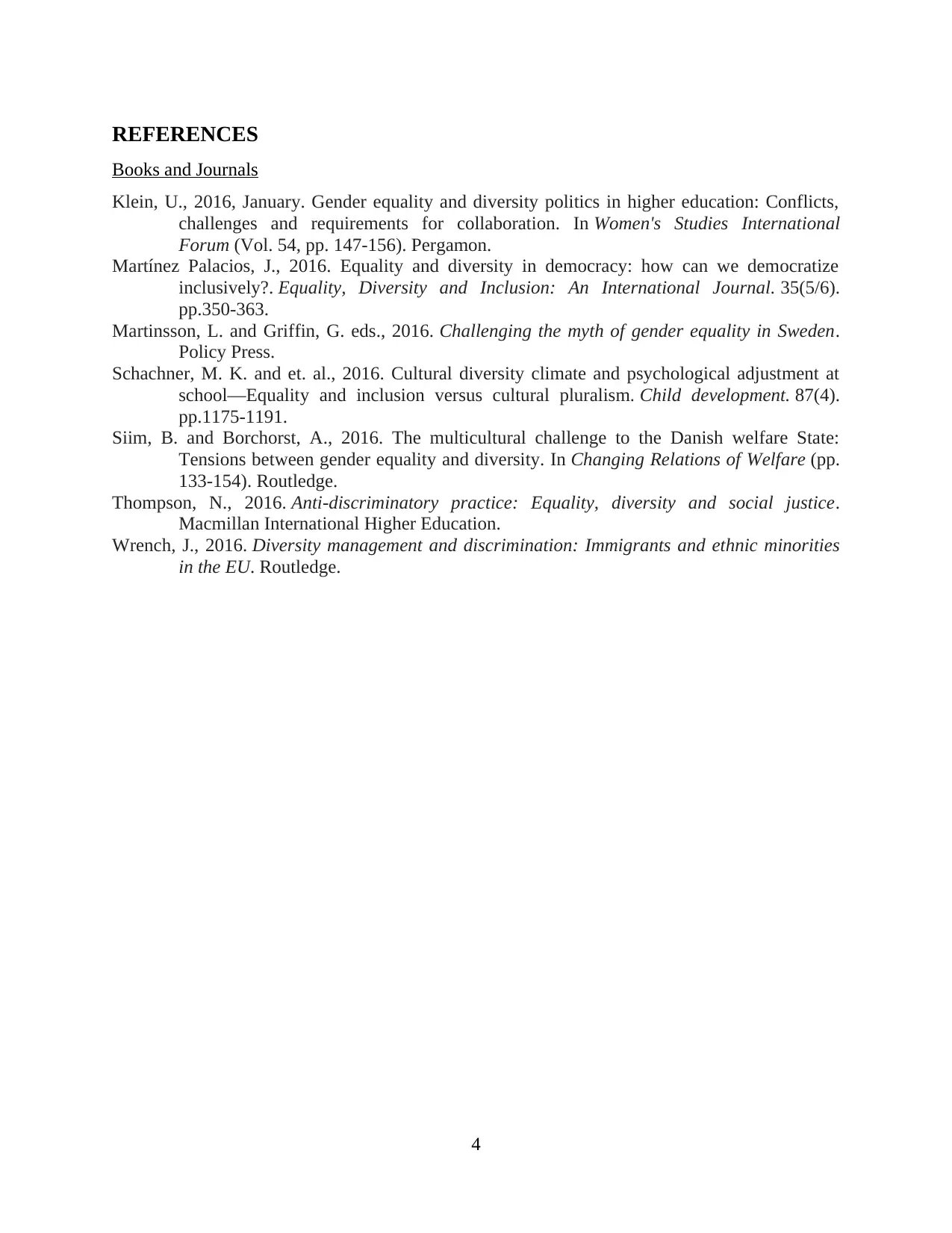
REFERENCES
Books and Journals
Klein, U., 2016, January. Gender equality and diversity politics in higher education: Conflicts,
challenges and requirements for collaboration. In Women's Studies International
Forum (Vol. 54, pp. 147-156). Pergamon.
Martínez Palacios, J., 2016. Equality and diversity in democracy: how can we democratize
inclusively?. Equality, Diversity and Inclusion: An International Journal. 35(5/6).
pp.350-363.
Martinsson, L. and Griffin, G. eds., 2016. Challenging the myth of gender equality in Sweden.
Policy Press.
Schachner, M. K. and et. al., 2016. Cultural diversity climate and psychological adjustment at
school—Equality and inclusion versus cultural pluralism. Child development. 87(4).
pp.1175-1191.
Siim, B. and Borchorst, A., 2016. The multicultural challenge to the Danish welfare State:
Tensions between gender equality and diversity. In Changing Relations of Welfare (pp.
133-154). Routledge.
Thompson, N., 2016. Anti-discriminatory practice: Equality, diversity and social justice.
Macmillan International Higher Education.
Wrench, J., 2016. Diversity management and discrimination: Immigrants and ethnic minorities
in the EU. Routledge.
4
Books and Journals
Klein, U., 2016, January. Gender equality and diversity politics in higher education: Conflicts,
challenges and requirements for collaboration. In Women's Studies International
Forum (Vol. 54, pp. 147-156). Pergamon.
Martínez Palacios, J., 2016. Equality and diversity in democracy: how can we democratize
inclusively?. Equality, Diversity and Inclusion: An International Journal. 35(5/6).
pp.350-363.
Martinsson, L. and Griffin, G. eds., 2016. Challenging the myth of gender equality in Sweden.
Policy Press.
Schachner, M. K. and et. al., 2016. Cultural diversity climate and psychological adjustment at
school—Equality and inclusion versus cultural pluralism. Child development. 87(4).
pp.1175-1191.
Siim, B. and Borchorst, A., 2016. The multicultural challenge to the Danish welfare State:
Tensions between gender equality and diversity. In Changing Relations of Welfare (pp.
133-154). Routledge.
Thompson, N., 2016. Anti-discriminatory practice: Equality, diversity and social justice.
Macmillan International Higher Education.
Wrench, J., 2016. Diversity management and discrimination: Immigrants and ethnic minorities
in the EU. Routledge.
4
⊘ This is a preview!⊘
Do you want full access?
Subscribe today to unlock all pages.

Trusted by 1+ million students worldwide
1 out of 6
Related Documents
Your All-in-One AI-Powered Toolkit for Academic Success.
+13062052269
info@desklib.com
Available 24*7 on WhatsApp / Email
![[object Object]](/_next/static/media/star-bottom.7253800d.svg)
Unlock your academic potential
Copyright © 2020–2025 A2Z Services. All Rights Reserved. Developed and managed by ZUCOL.





